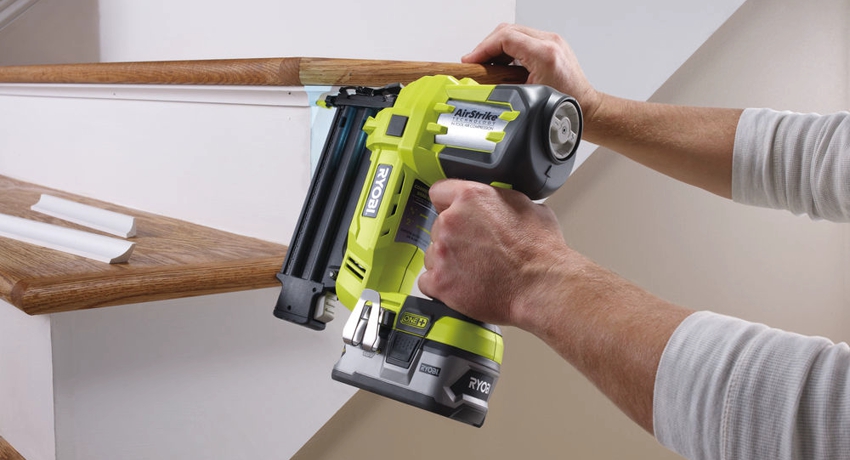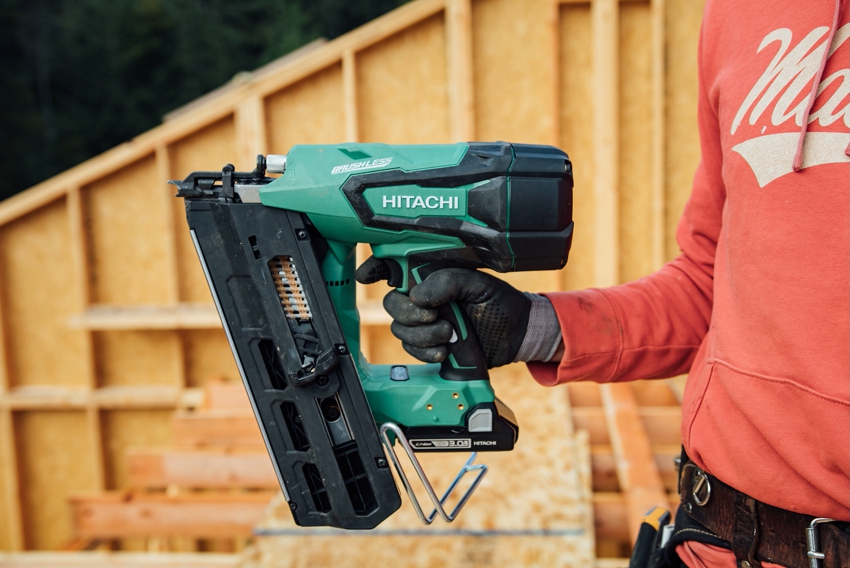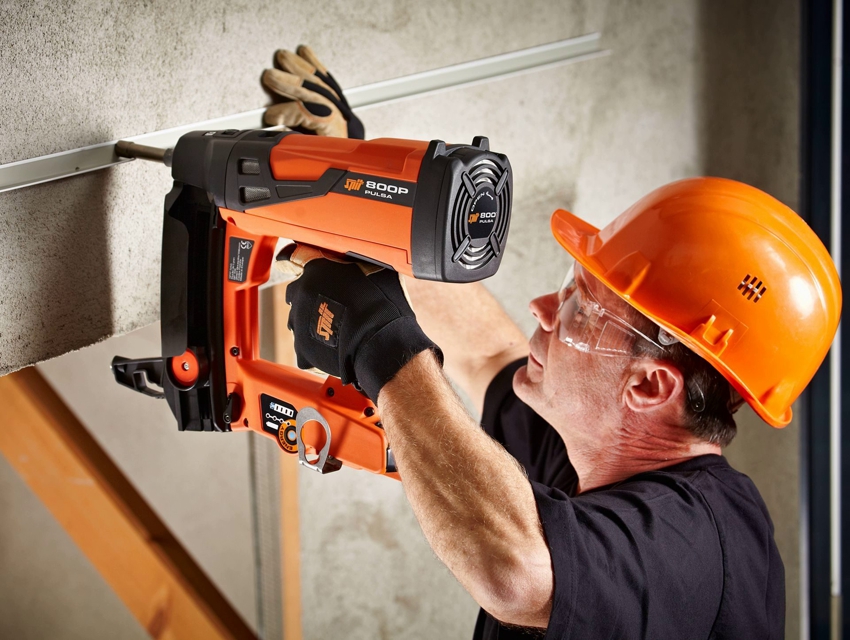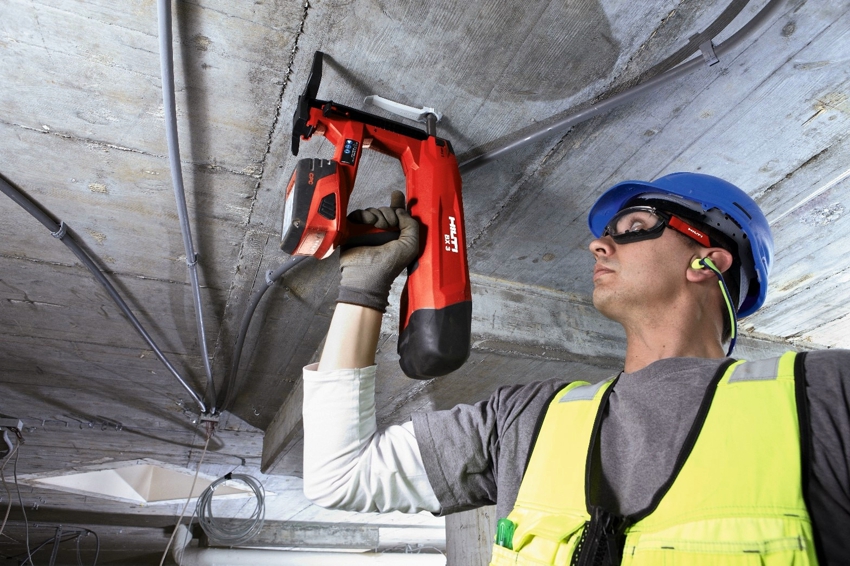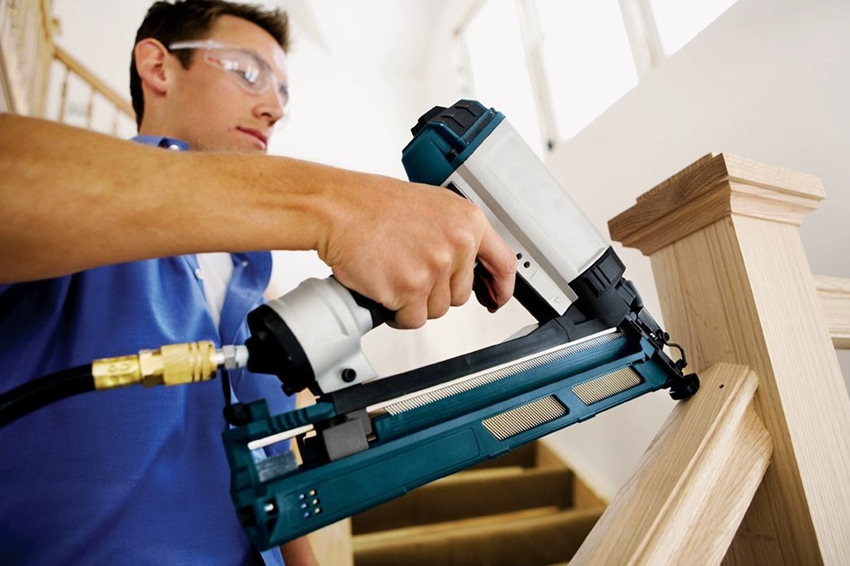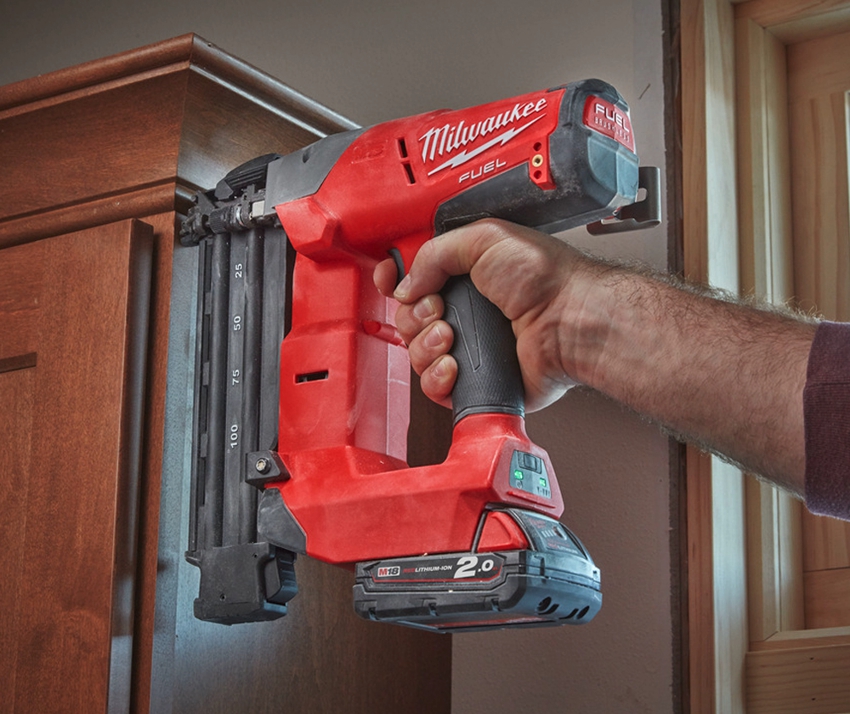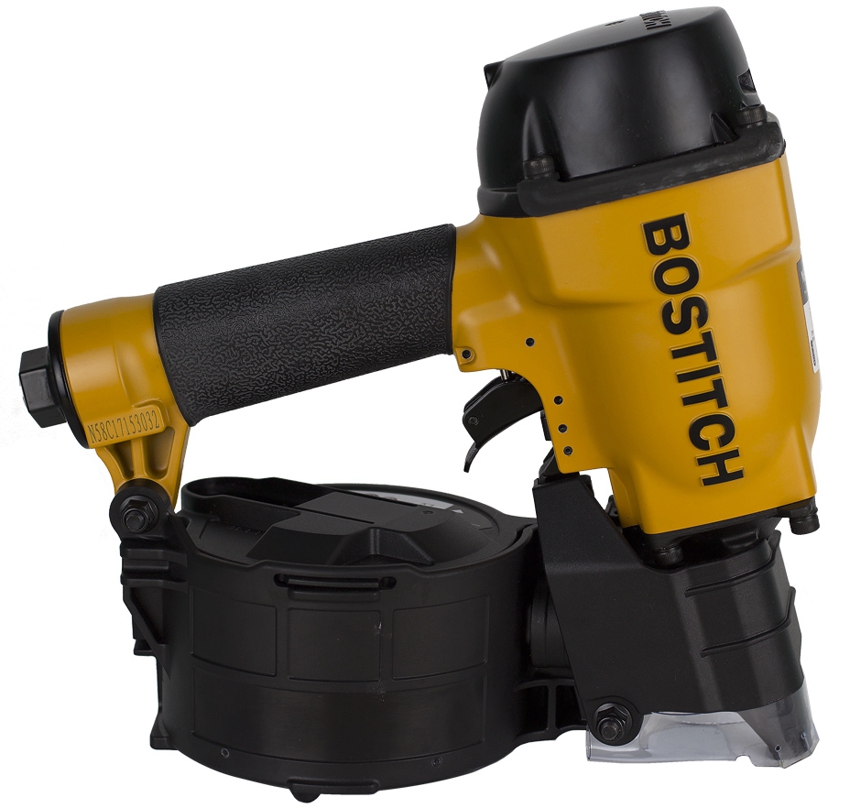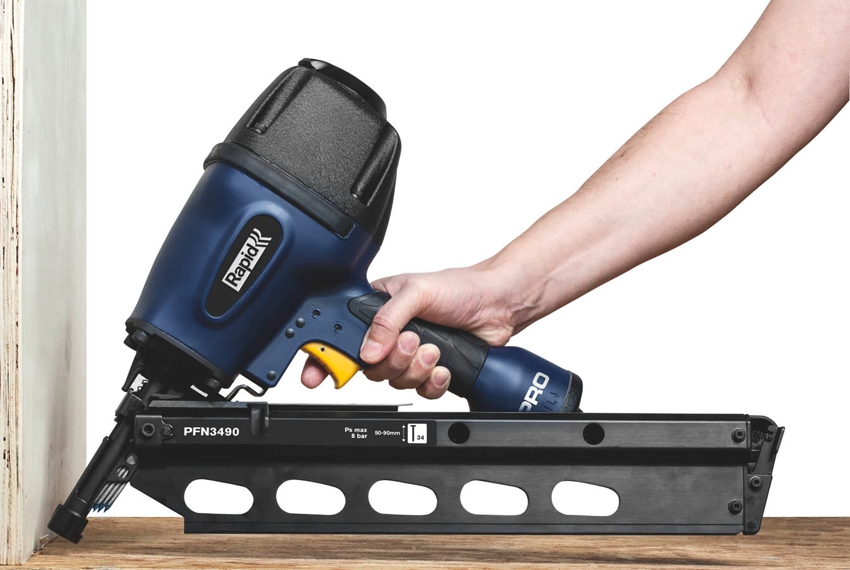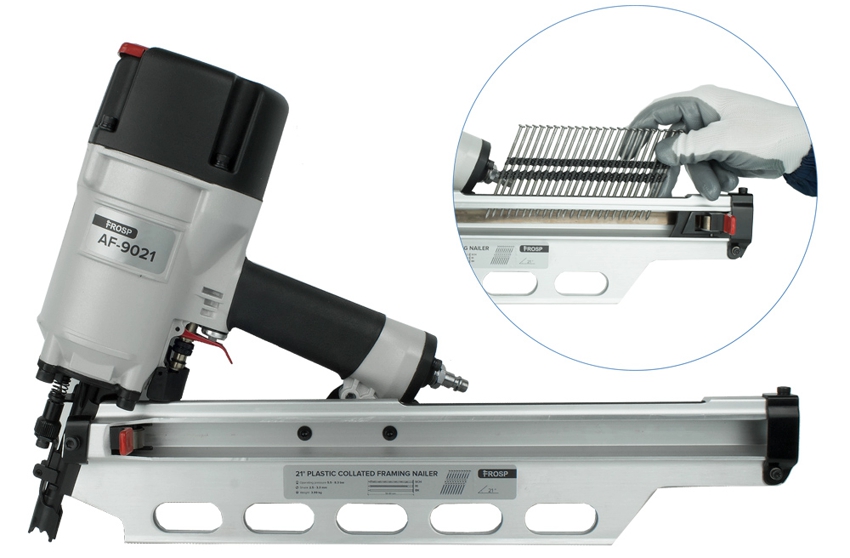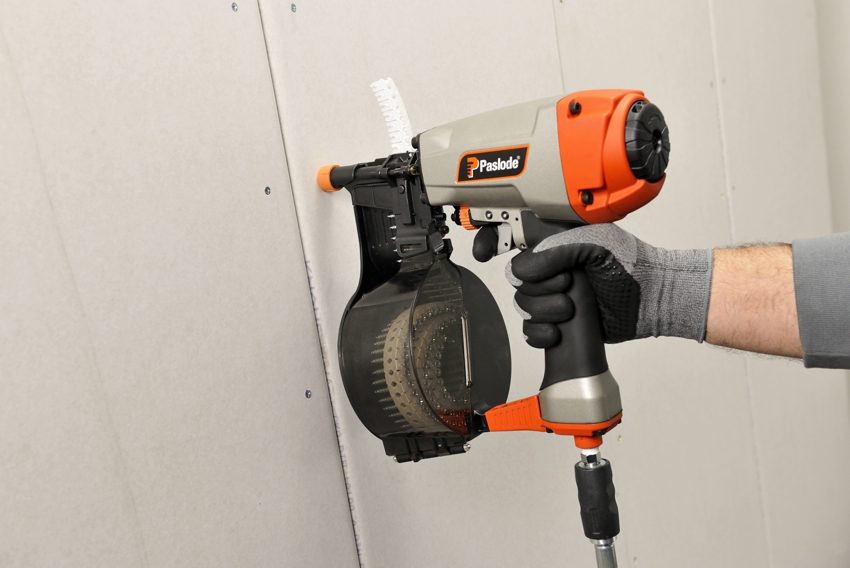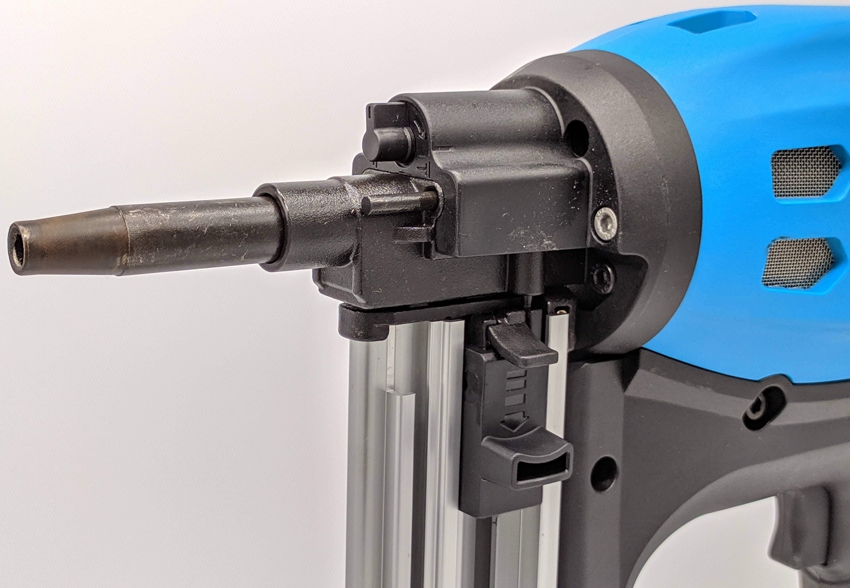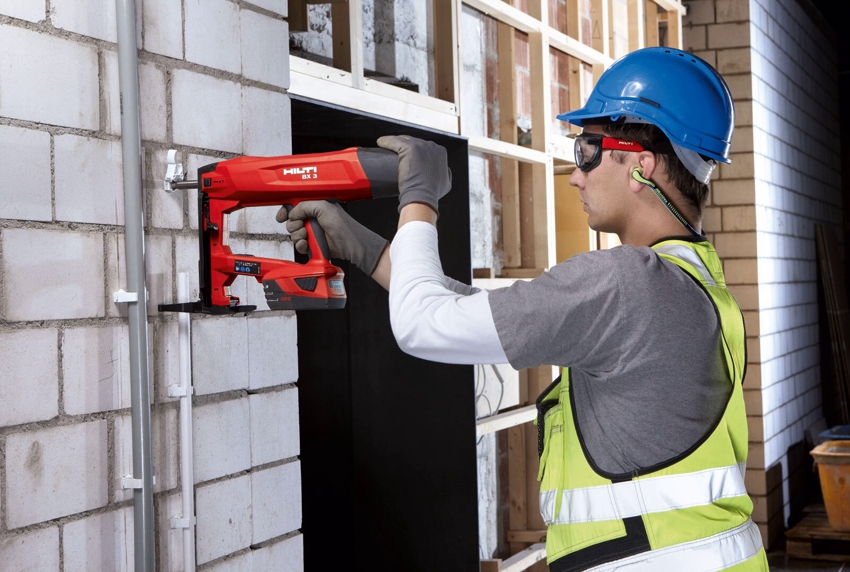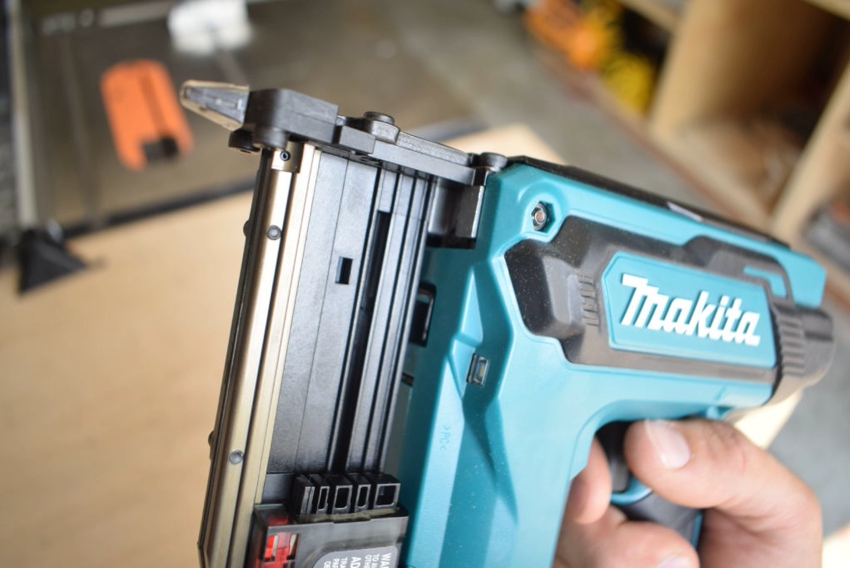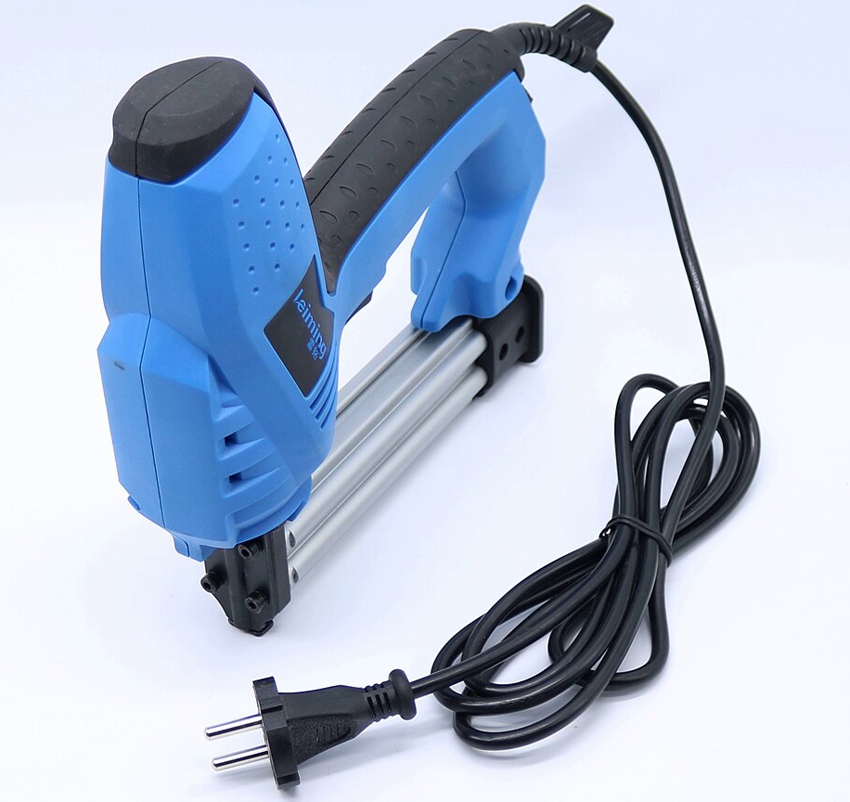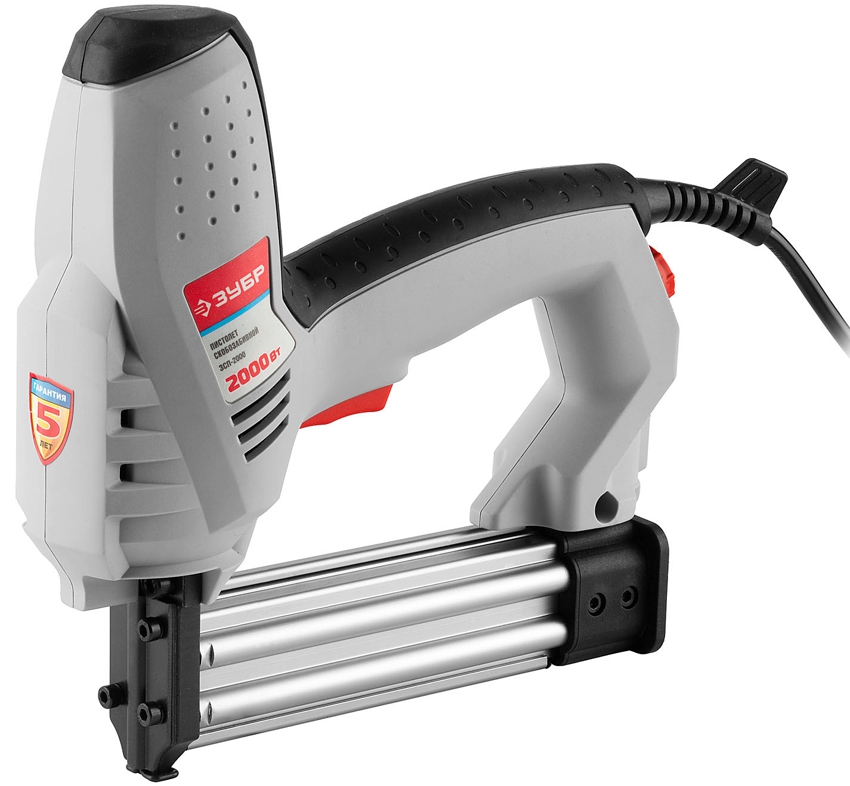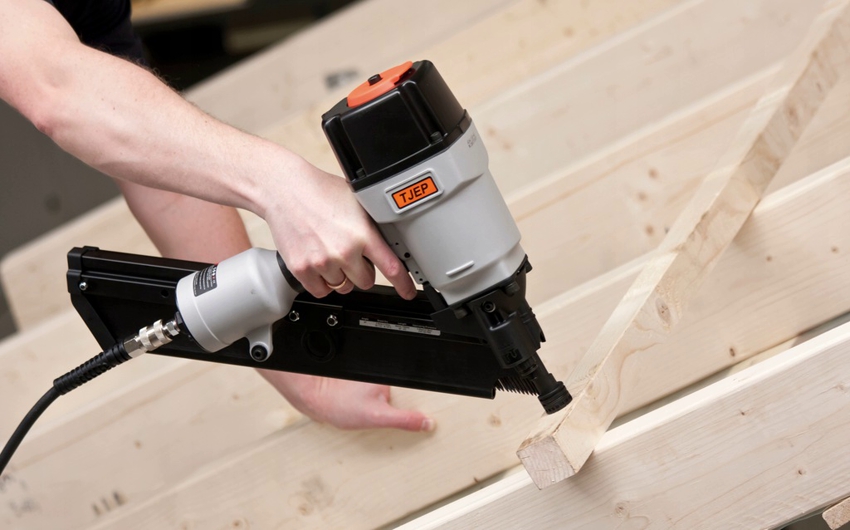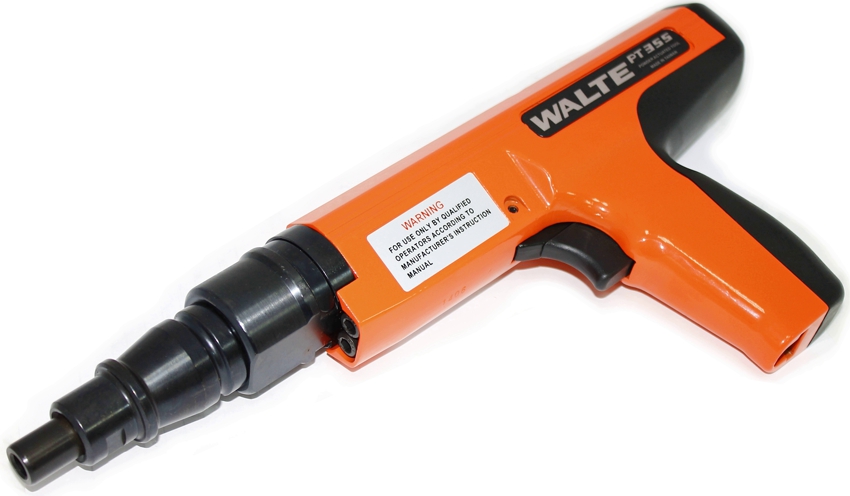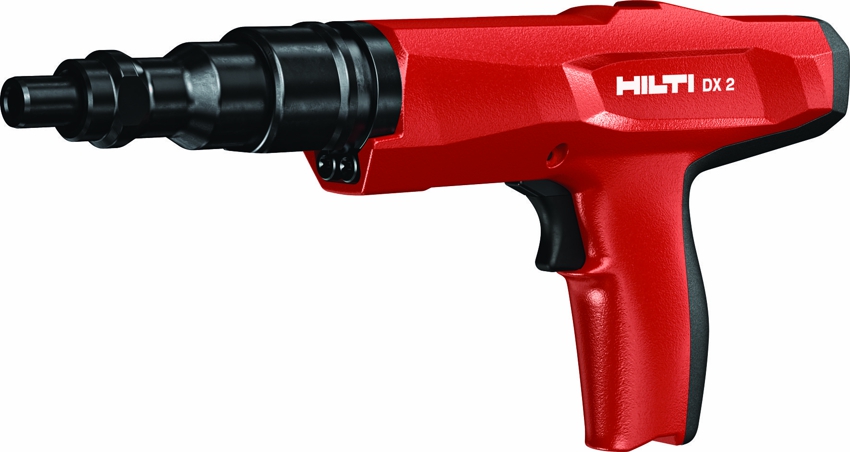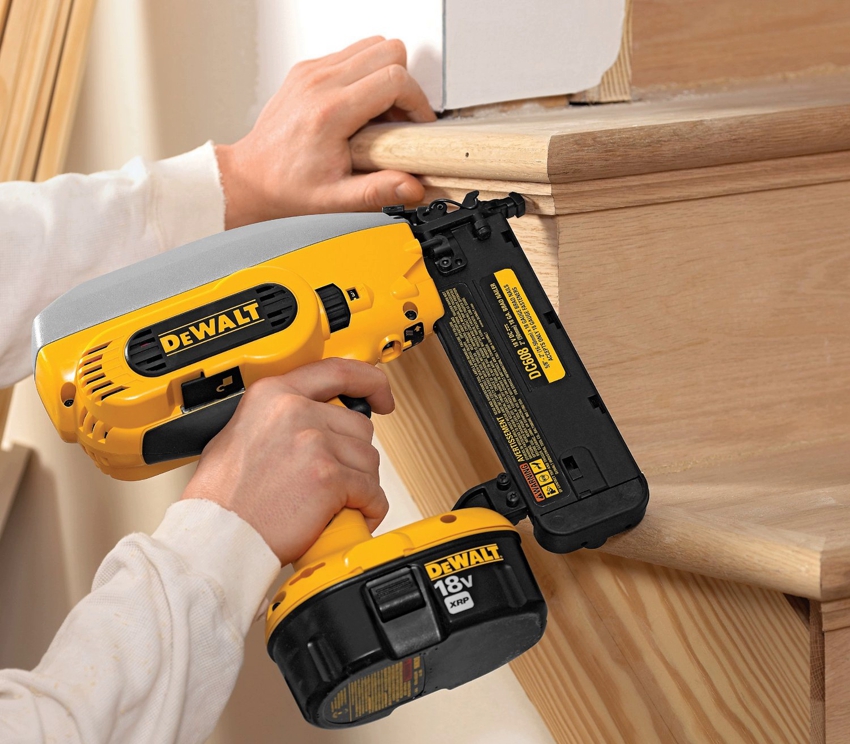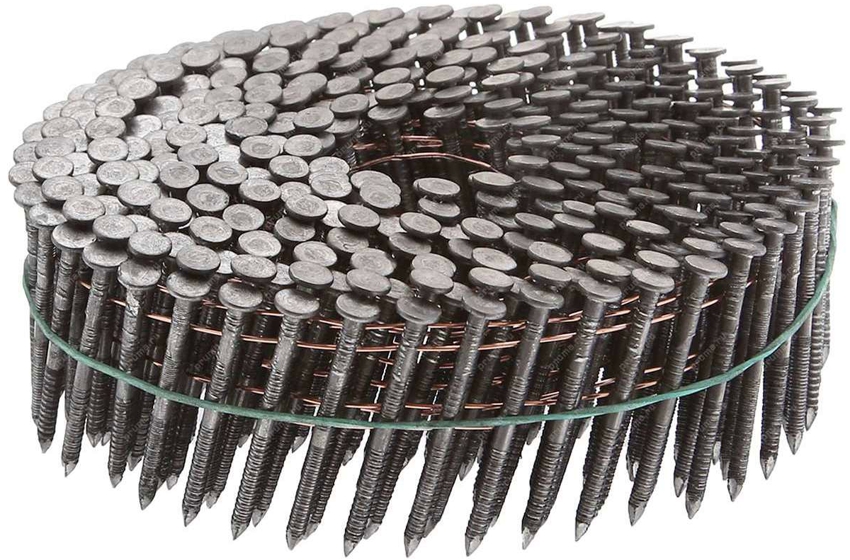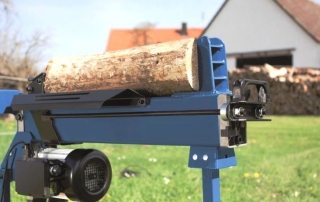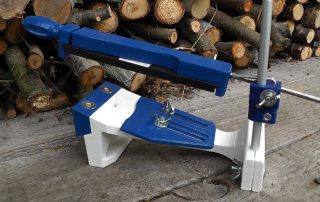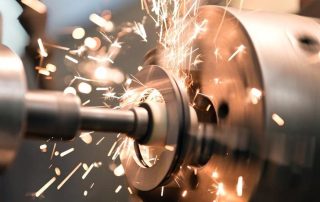A gun for nails for wood greatly simplifies and reduces the time for construction and installation work, so the question of choosing a quality tool for many craftsmen is in the first place. The information presented in this article will help you understand the species diversity of nailers, evaluate the advantages and disadvantages of each of them, compare the characteristics and capabilities in order to come to a final decision before going to the store.
Content
- 1 A gun for nails for wood: device and purpose
- 2 The main types of construction nail guns
- 2.1 General characteristics of pneumatic hammers for nails
- 2.2 Advantages and disadvantages of pneumatic nail guns
- 2.3 Features of gas construction guns: pros and cons
- 2.4 Advantages and Disadvantages of Gas Cordless Nail Guns
- 2.5 Feature of Electric Wood Nail Guns
- 2.6 Advantages and Disadvantages of Electric Nail Hammers
- 2.7 Characteristics of powder pistols for dowel-nails: pros and cons
- 3 Features of choosing an electric nailer with a battery
- 4 Common sizes and types of nails for nailers
A gun for nails for wood: device and purpose
Wood nailing guns are used for finishing and construction works, as well as for assembling and repairing furniture structures. Outwardly, the nailer resembles a pistol, hence its name.
The structure consists of the following elements:
- body part;
- shop with fasteners (nails);
- lever;
- trigger trigger;
- piston.
The principle of the tool is quite simple. When you pull the trigger or lightly touch the surface with the nose, the energy from the drive is transferred to the piston. He hits the fasteners and the nail is driven into the base. After that, the piston automatically returns to its original place. The next nail in the store is fed into the barrel of the pistol, and the operation is repeated.
The average speed of the nail gun is 1 to 3 shots per second, and the internal pressure in the tool reaches 4-6 atmospheres.
Purpose and scope of application of the nail gun
Neilers are designed for assembling various designs. With their help, installation and finishing works are carried out. Pistols are useful wherever wood is used.
Scope of the tool:
- construction of residential buildings;
- furniture manufacture;
- Finishing work;
- repair of premises;
- woodworking industry;
- production of various containers.
Helpful advice! There are finishing nail guns on sale. If studs or pins are used instead of standard fasteners, the joints on the finished surfaces will be barely visible.
With the help of a nailer, you can perform the following types of work:
- arrangement of the rafter system;
- installation of insulation materials;
- fastening of communication systems;
- installation of roll and profile materials, tiles and other roofing coatings;
- assembly of lathing structures;
- installation of panels;
- arrangement of the frame part in wooden houses;
- construction of staircase structures;
- fixing stretch ceilings;
- assembly of formwork structures;
- sheathing of the frame with plywood, clapboard, plasterboard sheets, chipboard, OSB, siding;
- assembly of door, window frames, etc.
Decorative nail guns can be used to neatly secure skirting boards, moldings and door casings. In just a few seconds, the nailer is capable of hammering in about 10 fasteners. This makes the process of laying linoleum quick and easy.
Unlike a hand hammer, this tool has a number of useful advantages:
- There is no damage to the finished surface, no dents or chips from the use of the gun.
- High speed of work.
- One person can cope with the task, which means you can reduce the number of workers and save on wages.
- High productivity (the worker's efficiency increases by 3-4 times).
- Reduces the risk of injury while working.
- Installation of fasteners does not require significant human effort. A craftsman can hammer in thousands of nails without feeling tired.
Pistols also have disadvantages. Each type of nailer has its own, so before buying a tool, it is advisable to study the pros and cons of each of them.
The main types of construction nail guns
It takes a lot of energy to set nails to the required depth, so the guns must have sufficient power reserves. To ensure this figure is at the desired level, the developers have used different approaches to creating the tool. As a result, several varieties of pistols appeared on the market, which differ from each other not only in their design, they have different characteristics.
By the type of drive, the following types of tools are distinguished:
- pneumatic nail guns;
- gas nailers;
- powder models;
- electric guns.
There are mechanical versions of pistols - staplers. To drive the fasteners into the base, the tool uses the energy of a compressed spring. This element is set in motion when the trigger on the handle is pressed. Staplers use staples as fasteners. Sometimes on sale you can find combined models that are also designed for nails.
The advantages of staplers:
- Compact size and light weight.
- Low cost.
- Simple system of use.
- Safe operation.
Note! Power guns are not suitable for tough jobs. They are suitable for solving elementary tasks, for example, furniture constriction or installation of soft materials (chipboard, plywood). This type of tool is not capable of generating enough power to drive nails into solid surfaces.
General characteristics of pneumatic hammers for nails
Compressed air models are especially popular with craftsmen. Many companies are engaged in the manufacture of pneumatic nail guns for wood, so there is a huge assortment on the market. Buyers can purchase models of any size and purpose.
On sale there are nylons for finishing work, which use thin short studs as fasteners, as well as dimensional pistols for assembling wooden frames. Models such as the Haubold RN 220R can easily hammer in nails with a diameter of 4-5 mm and a length of up to 220 mm.
The principle of operation is the same for all models of pneumatic guns. To hammer nails, the energy of compressed air is used, therefore, a compressor (from 6 to 24 liters) is necessarily present in the design. For normal operation of most guns, a pressure of 4-6 bar is sufficient. This is a standard figure for budget compressors.
Usually the manufacturer indicates the recommended compressor performance level in the documentation. In addition, the volume of the receiver required for normal operation is indicated. Some companies even indicate how much air the tool consumes per shot.
There are pneumatic nailer guns that can operate at high pressure. Models that are rated for 18-30 bar in terms of power level can compete with gas and powder nailers.
Advantages and disadvantages of pneumatic nail guns
During operation, the pneumatic nail gun is connected to the compressor with a high pressure hose. This design solution partially constrains the movements of the master. Modern air hoses are characterized by good elasticity and low weight. If you purchase a product of sufficient length, this tool drawback becomes insignificant. The outer section of the hoses varies from 8 to 12 mm.
Just like electric hammers for hammering in nails, pneumatic models are plug-dependent, but in this case, manufacturers offer several convenient solutions. Some companies produce compact compressors specially for their equipment. These models have a lightweight design and optimal performance parameters.
Note! On sale there are compressors equipped with a battery. The battery is capable of providing the instrument with energy for 30 minutes. continuous work.
Advantages of pneumatic nail guns:
- Simple and robust design with compact dimensions.
- High performance (up to 3-5 shots per second, the indicator does not depend on the type of fastener and the strength characteristics of the surface).
- Affordable cost.
- Light weight (about 1-3 kg).
- Simple operation system, the tool does not need expensive and complicated maintenance.
- Versatility and safety (use in rooms with high humidity or explosive conditions, in confined spaces is allowed).
- High power rating (up to 100 J).
- No special permits are required to operate the tool.
- Low noise level, minimal recoil.
The pneumatic nailer is safe and efficient. It is ideal for woodworking and is widely used in furniture making. In addition to being tied to a power supply and difficulties with an air hose, this type of tool has another drawback - the gun cannot function without a compressor and cylinders filled with compressed air.
Features of gas construction guns: pros and cons
Gas pistols are mobile structures that are powered by explosive energy. For this, a gas-air mixture is used. These pistols are widely used in the construction of wooden houses.
Related article:
Reciprocating cordless saw: a tool for garden maintenance and workpiece processing
Features, advantages and disadvantages. Selection recommendations. Additional features.Rating of the best independent saber saws.
Gas nailers are suitable for assembling frames and rafter systems. On some models, the fastener magazine is tilted. For example, in Toua rack and pinion guns, the mounting nails are positioned at an angle of 30-34 °, which allows access to the most difficult and narrow spaces between the beams.
The principle of operation is in many ways similar to that of an internal combustion engine:
- Liquefied gas (propane-butane mixture) is supplied to the working chamber of the tool from the cartridge.
- The fan helps to mix the gas with the air.
- The resulting mixture is ignited by a spark from a candle. The latter is powered by a built-in battery.
- The energy generated by the microexplosion is fed to the working piston.
- With a strong movement, the piston drives the fastener into the base.
Note! Gas models have impressive power. They are powerful enough to drive metal dowels into hard surfaces. They can be used for direct mounting in metal or concrete. This does not require pre-drilling the surface.
Advantages and Disadvantages of Gas Cordless Nail Guns
Gas nailers need consumables. In addition to fasteners, you will also have to buy cans filled with gas. Most often they come with the tool in a clear ratio. The amount of gas is exactly the same as the number of nails. Thanks to this, the buyer can independently determine the cost of one shot.
Advantages of gas nail guns:
- Convenience through autonomous operation and ergonomic design, which is achieved by eliminating hoses and wires.
- High impact force, allowing for installation work directly on surfaces such as wood, concrete, steel, brick.
- No special is required for operation. permissions.
- Average weight (within 2.5-4 kg).
- Simple application system, no special maintenance required.
- You do not need to pull the trigger hard to activate the tool.
Powerful models of cordless nail guns for wood can be an alternative solution if you do not have a hammer, drill, or hammer at hand.
Disadvantages of gas nailers:
- Exhaust of waste gas is dangerous for humans; in the process of work, the room must be well ventilated. If this is not possible, do not use the tool in confined spaces.
- The combustion chamber needs periodic cleaning.
- Large construction size (when compared to pneumatic models).
- You need to track the amount of charge in the battery.
Feature of Electric Wood Nail Guns
Electric nail guns are considered to be the least powerful of all existing types of nailers (2 kW). This type of tool is designed for small fasteners (pins, pins), so it is most often used for finishing work. It is ideal for mounting plastic lining, since a light impact does not damage the soft surface, and the fastening zones are neat and barely visible. The average speed is 20 beats per minute.
There are two types of electric nail guns:
- Rechargeable.
- Network.
In both cases, the instrument is driven by an electrical impulse. Network structures are directly connected to the power supply. Cordless models are driven by impulse. It is generated by the energy stored in the battery and transferred to an electromagnetic coil.
The cost of electric nail guns is much higher than that of other models.The cost of purchasing the tool will pay off only if it is used for professional purposes. To solve everyday problems and minor repairs, you can limit yourself to a cheaper option.
Important! Do not use electrical models in rooms with high air humidity (such as a bathroom).
Advantages and Disadvantages of Electric Nail Hammers
Cordless nailers are compact and mobile. They do not need to be connected to an electrical network for operation, so they are more convenient to use.
The advantages of an electric tool:
- Profitability (low cost per shot).
- Compact design, network models are lightweight.
- Battery models are mobile and completely autonomous.
- Maintenance is low cost and effortless.
- There is no gas exhaust.
- Low vibration and noise levels.
- Simple system of use.
Electric nailers can work on a variety of surfaces, including wood and brick. However, they are not without drawbacks.
Disadvantages of electric hammers for driving nails:
- Low power.
- The tool is not capable of hammering in fasteners larger than 65 mm, therefore its scope is limited to finishing work.
- It is not allowed to operate the tool in rooms with high air humidity and explosive atmosphere.
- Low operating speed (1 shot per second).
- The high cost of the tool.
Note! High-quality models provide a two-level protection against sudden operation. To activate the tool, its nose must be firmly pressed against the surface. It will not work if pressed accidentally.
Characteristics of powder pistols for dowel nails: pros and cons
The working piston is set in motion when a charge is ignited in the construction chuck. The principle of operation of powder models is in many ways similar to the operation of firearms. The force of impact with which the fasteners are driven into the base depends on the power of the cartridge. These consumables come in different calibers. Each of them is marked with its own color. Also, the power of the shot depends on the exhaust. The master can adjust the output of burning gases.
The use of dowel nails for the assembly gun allows the installation of fasteners into hard surfaces, so many craftsmen are in no hurry to call powder models naylers. Foreign experts have been using this term for a long time, since a modern nailing tool in terms of power level can be compared with an assembly tool.
Powder constructions advantages:
- High impact power (from 300 to 550 J), which allows the use of the tool for direct mounting.
- Autonomy and mobility. The design has no wires, compressors with hoses, batteries.
- Foreign models are characterized by low weight.
- Compact dimensions.
- Large selection of nail types available for use.
Powder nailers are capable of operating in two modes - semi-automatic and automatic. Each of them has its own speed of feeding the nails, and the master can adjust the operation of the tool.
Disadvantages of powder models:
- Suitable exclusively for direct mounting.
- Exhaust is emitted during operation.
- To use the tool, you must obtain a special permit.
- The high cost of one hit (the cost of buying cartridges).
- The tool needs regular maintenance (many parts wear out quickly and require periodic cleaning).
- In the process, you need to firmly hold the tool with both hands.
Powder pistols are quite difficult to operate. Certain knowledge will be required in order to correctly select the power of the cartridges, the type of fastener and calculate the limiting distances (edge and center-to-center).
Important! It is forbidden to use powder models in a flammable environment.
Features of choosing an electric nailer with a battery
Unlike conventional electric guns, cordless models have a built-in blower. It provides the energy needed to operate the tool. Most models are equipped with Li-on batteries. Only these storage elements have sufficient capacity. They can provide the current output necessary for the normal functioning of the tool.
Almost all modifications of electric nail guns are equipped with one battery. For this reason, it is advisable to check before purchasing if there is an opportunity to purchase a spare battery. The difficulty lies in the fact that not every battery will fit. Guns may have different connector configurations.
It is better to give preference to running models with an extensive production series. If, after a few years, the manufacturer stops supplying certain pistols to the market, problems may arise with the purchase of spare parts. It is for this reason that limited editions should be avoided.
It is very important that the built-in blower has sufficient power. Otherwise, the pistol will not have the declared characteristics. He will not be able to drive 1-2 nails per second. Plus, the battery will wear out over a year and performance will drop even further. Some nailer models do not allow the use of consumables from other companies, they can only work in combination with branded products.
Common sizes and types of nails for nailers
The length of nails for a nailer is calculated in decimal units. This indicator varies between 25-130 mm. To determine the thickness, it is customary to rely on the American system, which is used for marking the cross-section of wires. Each pistol has its own caliber. The thickest nails are marked with number 11. The caliber of the thinnest is 23. All of them are rectangular, except for the 15th, it is round.
By the type of fasteners used, you can determine the purpose of the tool (diameter):
- nails 19-45 mm long - for roofing works (up to 14);
- fasteners up to 64 mm long - finishing (23-14);
- nails up to 70 mm long - cladding installation (15-14);
- nails for wood 100 mm - guns for mounting slate (5);
- fasteners up to 130 mm long - rack and frame pistols (up to 11), pallet assembly tools (up to 9).
Using a nail gun is the easiest and most practical way to speed up your finishing and installation work. When choosing a gun, be sure to take into account the operating conditions and the intended range of work. Only in this case the tool will be easy to use and will be able to solve the assigned tasks.
